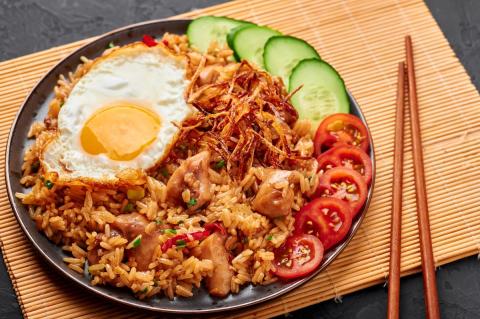
Divide the rice between two plates. Top each plate with a fried egg and garnish with cucumber and tomato slices. If you like, add some fried shallots for extra crunch and flavour. Serve immediately with kecap manis alongside for drizzling.
Tip
It’s essential to use refrigerated rice stored for a minimum of 12 hours and a maximum of 3 days to make nasi goreng. Using freshly cooked, hot rice will not yield the desired result. Cold, day-old rice has a firmer texture, allowing it to be stir-fried in the sauce, resulting in caramelisation that gives the dish its distinct colour and flavour.
History and origins
Indonesian nasi goreng originated in the 10th century when Southern Chinese immigrants arrived in the country. The Chinese technique of stir-frying leftover white rice from the night before was used to make breakfast the following day, and Indonesians adopted this Chinese tradition to create a new dish.
After Indonesia gained independence in 1945, nasi goreng was popularly considered a national dish, albeit unofficially. Its simplicity and versatility have contributed to its popularity and made it a staple among Indonesian households. It is regarded as the most democratic dish since the absence of a strict recipe has allowed people to customise it as they wish. In 2018, the Indonesian government officially recognised nasi goreng as one of the country’s national dishes.
Recipe variations
According to the Indonesian gastronome Dwi Larasatie, there are 104 types of nasi goreng found throughout the country. All of them are different because they have unique spices characteristic of their region. Here are some of the most popular Indonesian nasi goreng varieties.
Nasi goreng nanas (pineapple fried rice)
Nasi goreng nanas is made with rice, pineapple chunks, butter, garlic, shallots, spring onions, carrots, prawns, peas, fish sauce, oyster sauce, curry powder, turmeric, oil, and eggs. All the ingredients are sautéed in butter and stir-fried.
Nasi goreng mawut
Nasi goreng mawut is prepared by sautéing and blending a spice paste of garlic, onions, hot peppers, prawn sauce, fish sauce, and candlenuts. The dish’s main components – cooked rice, eggs, chicken thighs, meatballs, sausages, cabbage, egg noodles, and the spice paste – are stir-fried together over high heat to ensure the spices are well incorporated.
Nasi goreng kunyit (turmeric fried rice)
Nasi goreng kunyit is a traditional variety of fried rice popular in Indonesia, Malaysia and Singapore. The dish is prepared with rice, turmeric, ginger, chicken, oil, eggs, spring onions, soy sauce, salt, sugar and pepper. First, turmeric and ginger are fried in oil until they become fragrant, and then the chicken is added to the pan and browned. The cooked rice is added to the mixture and stir-fried. An egg is cracked in the middle, followed by the addition of spring onions. Finally, the dish is seasoned with soy sauce, salt, sugar and pepper.
Nasi goreng ayam
Nasi goreng ayam is a traditional Indonesian fried rice dish popular in Singapore, Brunei and Malaysia. Although this nasi goreng recipe has several variations, it’s usually made with chicken thighs, oil, salt, white pepper, shallots, rice, turmeric, soy sauce, fish sauce, galangal or ginger, garlic, spring onions, kecap manis and hot peppers. Most of the ingredients are stir-fried together with rice, and the dish is then garnished with fried eggs, shallots and sliced chilli peppers.
Storage
Once the nasi goreng has cooled, portion it into airtight containers and keep it in the fridge – it will keep for up to two days. To reheat the dish, you can either use a microwave or briefly stir-fry it until it’s heated through.



